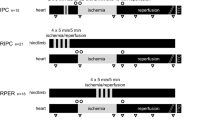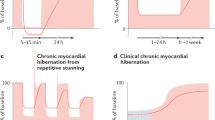Summary
The effect of repetitive brief periods of coronary occlusion on subsequent prolonged ischemic insult was studied using a swine heart model. Four 5-min episodes of left anterior descending coronary artery (LAD) occlusion, each separated by 10 min of reperfusion, did not affect any of the regional or global myocardial functions examined, except that the level of adenosine triphosphate (ATP) dropped to some extent. Sixty minutes of LAD occlusion following four repeated stunnings further reduced the ATP level, but this reduction was significantly lower compared to nonstunned control. Myocardial global functions were not affected significantly by prolonged ischemic insult. Segment shortening (SS) was reduced comparably in both control and stunned groups. However, SS improved significantly during subsequent reperfusion in the stunned group compared to control. The experimental group also demonstrated reduced infarct size and an area of risk compared to nonstunned control. These results indicate that repeated stunning prior to irreversible ischemic insult can attenuate ischemic injury and post-ischemic dysfunction.
Similar content being viewed by others
References
Bolli R, Zhu W, Thornby JI, O'Neill PG, Roberts R (1988) Time course and determinants of recovery of function after reversible ischemia in conscious dogs. Am J Physiol 254:H102-H114
Braunwald E, Kloner RA (1982) The stunned myocardium: prolonged postischemic ventricular dysfunction. Circulation 66:1146–1149
Cordis GA, Engelman RM, Das DK (1988) Novel dual-wavelength monitoring approach for the improved rapid separation and estimation of adenine nucleotides and creatine phosphate by high-performance liquid chromatography. J Chromatogr 459:229–236
Fujiwara H, Ashraf M, Sato S, Millard RW (1982) Transmural cellular damage and blood flow distribution in early ischemia in pig hearts. Circ Res 51:683–693
Kimura Y, Iyengar J, Engelman RM, Das DK (1990) Prevention of myocardial reperfusion injury in experimental coronary revascularization following ischemic arrest by a novel antiinflammatory drug, ONO-3144. J Cardiovasc Pharmacol 16:992–999
Klein HH, Puschmann S, Schaper W (1981) The mechanism of the tetrazolium reaction in identifying experimental myocardial infarction. Virchows Arch [A] 393:287–297
Lange R, Ware J, Kloner RA (1984) Absence of a cumulative deterioration of regional function during three repeated 5 or 15 minute coronary occlusions. Circulation 69:400–408
Millard RW (1981) Induction of functional coronary collaterals in the swine heart. Basic Res Cardiol 76:468–473
Murry CE, Jennings RB, Reimer KA (1986) Preconditioning with ischemia: a delay of lethal cell injury in ischemic myocardium. Circulation 74:1124–1136
Murry CE, Richard VJ, Reimer KA, Jennings RB (1990) Ischemic preconditioning slows energy metabolism and delays ultrastructural damage during a sustained ischemic episode. Circ Res 66:913–931
Otani H, Engelman RM, Rousou JA, Breyer RH, Clement R, Prasad R, Klar J, Das DK (1989) Improvement of myocardial function by trifluoperazine, a calmodulin antagonist, after acute coronary artery occlusion and coronary revascularization. J Thorac Cardiovasc Surg 97:267–274
Otani H, Engelman RM, Rousou JA, Breyer RH, Lemeshow S, Das DK (1986) Cardiac performance during reperfusion improved by pretreatment with oxygen free-radical scavengers. J Thorac Cardiovasc Surg 91:290–295
Reimer KA, Murry CF, Yamasawa I, Hill ML, Jennings RB (1986) Four brief periods of myocardial ischemia cause no cumulative ATP loss or necrosis. Am J Physiol 251:H1306-H1315
Rivas F, Cobb FR, Bache RJ, Greenfield JC, Jr (1976) Relation between blood flow to ischemic regions and extent of myocardial infarction. Circ Res 38:439–447
Savage RM, Guth B, White FC, Hagan AD, Bloor CM (1981) Correlation of regional infarct size during acute myocardial ischemia in the conscious pig. Circulation 64:699–707
Schott RJ, Rohmann S, Braun ER, Schaper W (1990) Ischemic preconditioning reduces infarct size in swine myocardium. Circ Res 66:1133–1142
Swain JL, Sabina RL, Hines JJ, Greenfield JC, Holmes EW (1984) Repetitive episodes of brief ischemia (12 min) do not produce a cumulative depletion of high-energy phosphate compounds. Cardiovasc Res 18:264–269
Vivaldi MT, Kloner RA, Schoen FJ (1985) Triphenyltetrazolium staining of irreversible ischemic injury following coronary artery occlusion in rats. Am J Pathol 121:522–530
Werns SW, Shea MJ, Mitsos SE, Dysko RC, Fantone JC, Schork MA, Abrames GD, Pitt B, Lucchesi BR (1986) Reduction of the size of infarction by allopurinol in the ischemic-reperfused canine heart. Circulation 73:518–524
Author information
Authors and Affiliations
Rights and permissions
About this article
Cite this article
Kimura, Y., Iyengar, J., Subramanian, R. et al. Preconditioning of the heart by repeated stunning: attenuation of post-ischemic dysfunction. Basic Res Cardiol 87, 128–138 (1992). https://doi.org/10.1007/BF00801960
Received:
Accepted:
Issue Date:
DOI: https://doi.org/10.1007/BF00801960




